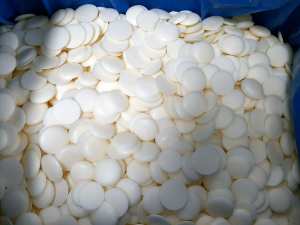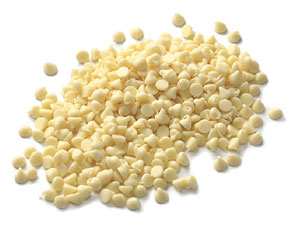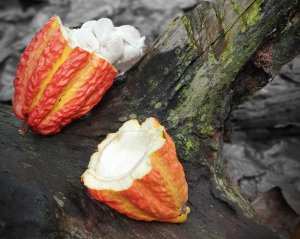



by OrganicCrops. Posted on 12 June 2023, 09:37 hrs
Welcome to the extraordinary world of cacao butter! This delicious superfood, hailing from the lush landscapes of Peru, is more than just a tasty treat. It's a powerhouse of nutrition, a key ingredient in numerous recipes, and a testament to sustainable farming practices. In this comprehensive guide, OrganicCrops, will take you on a journey from cacao farming to your kitchen table. Let's dive in!
Cacao butter, also known as Theobroma oil, is a natural, edible fat extracted from cacao beans. This creamy, white substance is the very essence of chocolate's luxurious character, contributing to its velvety texture and subtle, mouth-watering aroma. You may find yourself asking: is there a distinction between cacao butter and cocoa butter? Rest assured, they're one and the same! The difference lies merely in the spelling, not the substance.
From a culinary perspective, cacao butter is a versatile superstar. It's an essential ingredient in chocolate making, but it's also used in a variety of dishes, both sweet and savory. Deodorized cacao butter, which has its natural aroma removed, offers the same culinary benefits without the distinctive chocolate scent, making it a perfect fit for more diverse recipes and as an ingredient for cosmetic products.
But cacao butter isn't just a culinary marvel—it's also a superfood, packed with nutrients and health benefits. And when it's organic, like the cacao butter from OrganicCrops, it's free from synthetic pesticides and fertilizers, making it even better for you and the planet.
The cultivation of cacao in Peru dates back thousands of years. One archaeological site in the northern part of the country has evidence of cacao use that dates back to around 1200 BC. However, the production of cacao butter would have only been possible after the introduction of certain technologies.
After the Spanish conquest of the Inca Empire in the 16th century, cacao became a major export crop. The Spanish were the first Europeans to encounter cacao, and they brought it back to Europe where it became a popular luxury good. The process of extracting cacao butter from cacao beans was likely developed during this period.
In the 20th century, cacao cultivation in Peru was affected by several factors. The development of hybrid cacao varieties led to increased production, but also made the crop more susceptible to disease. Changes in global commodity markets and national economic policies also had an impact on the Peruvian cacao industry.
In recent years, Peruvian cacao has gained a reputation for its high quality, and there has been increased interest in single-origin chocolates made from Peruvian cacao. This has likely increased the production and use of Peruvian cacao butter as well.
Cacao butter's journey begins with the cacao tree (Theobroma cacao), a tropical plant native to the Americas' rainforests. The tree produces large, oval-shaped pods, each filled with 20 to 60 cacao beans enveloped in a sweet pulp. These trees thrive under specific conditions: a humid climate, steady temperatures, and a canopy of shade. This makes countries in Latin America, specifically Peru, ideal locations for cacao farming.

The cacao harvesting process is a labor of love, requiring careful manual labor. Once the cacao pods are ripe, farmers cut them from the trees and crack them open to extract the beans. These beans are then fermented, a crucial step that develops the beans' flavor profile. After fermentation, the beans are dried under the sun and finally packed into bags and transported from the farm to the processing plant.
In the case of deodorized or refined cacao butter, a physical deodorization process is employed after the pressing stage. This deodorization process helps to produce organic deodorized cacao butter without the use of chemicals.
 Deodorized cacao butter holds a special place in the cosmetics industry due to its neutral scent and rich moisturizing properties. Unlike natural cacao butter, which has a strong chocolate scent, deodorized cacao butter has the majority of its aroma removed, making it an ideal base for skincare products where a neutral scent is desired. Its creamy texture and emollient properties make it a popular ingredient in lotions, creams, lip balms, and soaps. It provides hydration, nourishment, and protection to the skin, without overpowering other fragrances used in cosmetic formulations. Thus, deodorized cacao butter is a versatile ingredient, enhancing the sensory experience of cosmetic products while also delivering significant skincare benefits.
Deodorized cacao butter holds a special place in the cosmetics industry due to its neutral scent and rich moisturizing properties. Unlike natural cacao butter, which has a strong chocolate scent, deodorized cacao butter has the majority of its aroma removed, making it an ideal base for skincare products where a neutral scent is desired. Its creamy texture and emollient properties make it a popular ingredient in lotions, creams, lip balms, and soaps. It provides hydration, nourishment, and protection to the skin, without overpowering other fragrances used in cosmetic formulations. Thus, deodorized cacao butter is a versatile ingredient, enhancing the sensory experience of cosmetic products while also delivering significant skincare benefits.
When we think about the foods we consume, it's essential to consider not only their taste and nutritional benefits but also their impact on our planet. Sustainability is a critical aspect of modern agriculture, and cacao butter is no exception.
Cacao farming, particularly in Peru, is closely tied to the health of the environment and the well-being of farming communities. The good news is that cacao trees, when grown sustainably, can support biodiversity, conserve local ecosystems, and help fight climate change by absorbing carbon dioxide.
At OrganicCrops, sustainability isn't just a buzzword—it's a core commitment. We work directly with Peruvian farmers, promoting organic farming practices that respect nature's rhythms and cycles. This approach not only helps protect Peru's rich biodiversity but also ensures that the cacao butter you enjoy is as pure and natural as it can be.
But sustainability isn't just about the environment—it's also about people. OrganicCrops is dedicated to fair-trade practices, ensuring that the farmers who pour their hearts into growing and harvesting cacao beans are paid a fair wage for their work. This commitment to fairness and respect extends throughout their entire supply chain, from the Peruvian fields to your table.
We are proud to offer a range of options for purchasing our high-quality cacao butter, designed to meet your specific needs. Whether you're a trader, a wholesaler or a manufacturer, we've got the perfect cacao butter format for you.
Our cacao butter comes in several presentations, making it easy for you to choose the one that fits your requirements:
 Bulk Blocks: For those who need cacao butter in large quantities, our bulk blocks are a perfect choice. These come in sizes of 5, 20, or 25 kg. For your convenience, we pack four 5kg blocks into a sturdy corrugated cardboard box, creating a total weight of 20 kg. These bulk blocks are ideal for manufacturers, professional bakers, and chefs who use cacao butter as a staple ingredient.
Bulk Blocks: For those who need cacao butter in large quantities, our bulk blocks are a perfect choice. These come in sizes of 5, 20, or 25 kg. For your convenience, we pack four 5kg blocks into a sturdy corrugated cardboard box, creating a total weight of 20 kg. These bulk blocks are ideal for manufacturers, professional bakers, and chefs who use cacao butter as a staple ingredient. Bars: Available in 50g or 85g sizes, our cacao butter bars are perfect for individual use. Whether you're creating a personal culinary masterpiece or a DIY skincare product, these bars are conveniently sized for small-scale applications.
Bars: Available in 50g or 85g sizes, our cacao butter bars are perfect for individual use. Whether you're creating a personal culinary masterpiece or a DIY skincare product, these bars are conveniently sized for small-scale applications.Our cacao butter is available in both organic and conventional forms, and we offer both natural and deodorized variants. This ensures that you can choose the type that best suits your needs and preferences.
In terms of packaging, we offer bulk options in corrugated cardboard boxes for larger orders. For smaller orders or for those interested in reselling our products, we provide a private label option in retail packaging.
At OrganicCrops, we believe in giving our customers the highest quality products in the most convenient formats. That's why we offer a variety of options for our cacao butter. Whatever your needs or preferences, we have the perfect product for you.
Cacao butter isn't just a delicious ingredient; it's also a nutrient-dense superfood. Let's explore why this creamy delight is more than meets the eye.
Firstly, cacao butter is a fantastic source of healthy fats. It's high in saturated fats, predominantly stearic acid and palmitic acid, both of which have neutral effects on blood cholesterol levels. Cacao butter also contains a small amount of monounsaturated fat, known as oleic acid, which is heart-healthy and can help reduce bad cholesterol levels.
While cacao butter doesn't contain omega-3 fatty acids, it does have omega-6 fatty acids. However, it's important to balance your intake of omega-6 with omega-3, which can be found in foods like flaxseeds, chia seeds, and fatty fish.
But the health benefits of cacao butter don't stop at nutrition. It's also a boon for skin health. The fats in cacao butter form a protective barrier over your skin, helping to hold in moisture. Plus, cacao butter is rich in natural plant compounds called phytochemicals, which can improve blood flow to the skin and slow skin aging by protecting against damage from the sun's harmful UV rays.
When it comes to shelf life, both natural and deodorized cacao butter are winners. If stored correctly, cacao butter can last for 2-5 years, making it a great pantry staple.
Remember, as with all foods, moderation is key. While cacao butter has many health benefits, it's also high in calories, so it's best to consume it as part of a balanced diet.
Cacao butter is a fascinating substance with a complex chemical makeup. Notably, it remains a solid fat at room temperature, only transitioning to a liquid state when it reaches a melting point of around 30 to 34°C. Exhibiting a light yellow hue, cacao butter carries a distinctive aroma that subtly hints at its chocolate origins - after all, it is a primary ingredient in the chocolate we all know and love.
Delving deeper into its composition, we find that an unsaponifiable fraction makes up between 0.2% and 0.6% of cacao butter. This fraction comprises glycolipids, phospholipids, and phytosterols. The majority of its composition, however, is accounted for by triglycerides. These include stearic acid (comprising 34-36%), oleic acid (comprising 30-40%), and palmitic acid (comprising 24-29%). Additionally, there is a smaller proportion of linoleic acid (2.5-3.5%).
Thus, the triglycerides in cacao butter mainly consist of saturated (C16:0 – palmitic acid; C18:0 – stearic acid) and monounsaturated (C18:1 – oleic acid) fatty acids. This unique composition is responsible for many of cacao butter's distinct physicochemical properties, such as its solidity at room temperature. Through understanding these aspects, we can appreciate the remarkable nature of this superfood even more.
Cacao butter's remarkable emollient properties have cemented its position as a staple ingredient in the cosmetics and pharmaceutical industries. How does it work? Primarily, cacao butter forms a protective layer on the skin's surface. This barrier performs a dual function: it minimizes transepidermal water loss (TEWL), and also supplies lipids (in the form of triglycerides) to enhance the skin's protective emulsion. Notably, even when applied in its pure form, cacao butter is a delight for the skin, melting seamlessly upon contact. The result is a boost in skin hydration and elasticity, helping to alleviate the discomfort of dryness.
Given these benefits, it's not surprising that cacao butter is a popular ingredient in moisturizing products, particularly those designed for body hydration. You'll find it in an array of formulations, from solid balms and body butters to emulsions.
But the use of cacao butter extends beyond skin care. It's a vital component in many lipsticks, appreciated for its ideal melting temperature and appealing "after feel". If you've ever noticed a hint of chocolate in your lip products, especially moisturizing ones, that's likely the work of cacao butter. Additionally, due to its lubricating and moisturizing properties, cacao butter often features in hair care products such as conditioners and masks.
As a raw material in cosmetic formulations, cacao butter serves as a structural agent, contributing to consistency and viscosity. It's included in both anhydrous and emulsion formulations, typically as part of the oil phase. Storing cacao butter is straightforward, as it's best kept at room temperature (around 20-25°C), alongside other raw materials not requiring cold storage.
OrganicCrops provides a variety of cacao butter presentations suitable for all needs, including blocks, bars, wafers, and coins. We also offer deodorized options. In cosmetic formulations, cacao butter can comprise anywhere from 2% to 90% of the product, depending on the specific application. As a rough guideline, you might use 3-5% in emulsions, 3-10% in balms, and 5-90% in sticks. Cacao butter is added to the oil phase and heated alongside other butters and waxes until it melts (30-34°C).
Now that we've delved into the world of cacao butter, it's time to bring this superfood into your kitchen. The good news? Cacao butter is incredibly versatile, and there are countless ways to enjoy it.
Should you use cacao butter every day? Absolutely! But remember, moderation is key. Cacao butter is a calorie-dense food, so a little goes a long way.
 Deodorized cacao butter, with its neutral taste and aroma, is perfect for cooking and baking. You can use it in place of regular butter or oils in your favorite recipes, adding a smooth texture without altering the dish's flavor. From sautéing vegetables to baking cookies, deodorized cacao butter is a kitchen workhorse.
Deodorized cacao butter, with its neutral taste and aroma, is perfect for cooking and baking. You can use it in place of regular butter or oils in your favorite recipes, adding a smooth texture without altering the dish's flavor. From sautéing vegetables to baking cookies, deodorized cacao butter is a kitchen workhorse.
But what about natural cacao butter with its delightful chocolatey aroma? It's perfect for homemade chocolate, smoothies, and desserts. You can also add it to your morning coffee for a creamy, indulgent twist.
Yes, you can eat cacao butter straight! It's a delightful treat on its own, melting slowly in your mouth and releasing its rich flavors.
Drinking cacao butter? Sure! Try adding a small piece to your hot chocolate, coffee, or tea. As it melts, it creates a creamy, luxurious beverage that's truly comforting.
As for replacing regular butter with cacao butter, it's entirely possible in most recipes. However, keep in mind that cacao butter has a distinct flavor that can influence the taste of your dish. If you're going for a neutral flavor, deodorized cacao butter is your best bet.
In the realm of skincare, cacao butter is a natural moisturizer, lauded for its deep hydrating properties. It's rich in fatty acids, which can penetrate the skin for deep hydration, making it an excellent choice for dry or sensitive skin types.
For a simple, DIY moisturizer, gently melt cacao butter and allow it to cool before applying to your skin. Its natural antioxidant properties can help fight off free radical damage, making it a potential ally against the signs of aging.
Cacao butter also makes for a nourishing lip balm. Melt a small amount, mix it with a carrier oil like coconut or jojoba, and let it solidify. Apply to your lips for a natural, hydrating treatment that will protect against dryness and cracking.
For an indulgent, home-made body scrub, mix cacao butter with coarse sugar and your favorite essential oils. This will not only exfoliate your skin but also leave it feeling soft, hydrated, and rejuvenated.
Cacao butter can even be used as a natural shaving cream. Its rich, creamy texture allows for a smooth shave while moisturizing the skin, reducing the chance of razor burn.
But remember, just as with any new skincare product, it's wise to perform a patch test first. Apply a small amount of cacao butter to a discreet area of skin and wait 24 hours to make sure you don't have an adverse reaction.
From culinary creations to skincare solutions, cacao butter is truly a multi-purpose marvel. Its array of uses is a testament to its versatility, making it a worthy addition to your pantry and your skincare routine.
Cacao butter is a hardy ingredient, but like all natural products, it needs to be stored correctly to maintain its freshness and nutritional benefits. Here are some tips to ensure your cacao butter stays in top-notch condition.
Cacao butter should be stored in a cool, dry place, away from direct sunlight and heat sources. The pantry is an ideal location, but you can also store it in the refrigerator to prolong its shelf life.
If you choose to refrigerate your cacao butter, be sure to wrap it well or keep it in an airtight container to prevent it from absorbing odors from other foods. Cacao butter, especially the deodorized kind, can be sensitive to strong odors.
When it comes to shelf life, cacao butter is a winner. Natural and deodorized cacao butter can last between 2-5 years if stored correctly. This is because of cacao butter's high saturated fat content, which makes it less likely to go rancid compared to oils with high amounts of unsaturated fats. Even so, it's a good idea to check your cacao butter for signs of spoilage before use. If it develops an off smell, changes color, or shows signs of mold, it's best to discard it. By taking care of your cacao butter and storing it correctly, you can ensure that this delightful superfood remains ready for your culinary and skincare needs for years to come.
Cacao butter is truly a remarkable ingredient. From its rich history and sustainable production to its myriad health benefits and diverse applications, it's clear that this superfood is more than deserving of its celebrated status.
Whether you're a culinary enthusiast looking for a versatile and nutritious ingredient, a skincare aficionado seeking natural, hydrating solutions, or simply someone eager to explore the world of superfoods, cacao butter has something to offer. Its unique combination of flavor, health benefits, and sustainability make it an ingredient you can feel good about using every day.
At OrganicCrops, we're proud to provide high-quality, organic cacao butter that's ethically sourced and sustainably produced. Our commitment to supporting Peruvian farmers and promoting sustainable farming practices ensures that every bite you take, every dish you create, and every skincare concoction you whip up doesn't just serve you—it also supports a more equitable and sustainable global food system.
By choosing OrganicCrops cacao butter, you're not just making a decision that's good for you. You're also making a choice that's good for farmers, for the environment, and for the future.